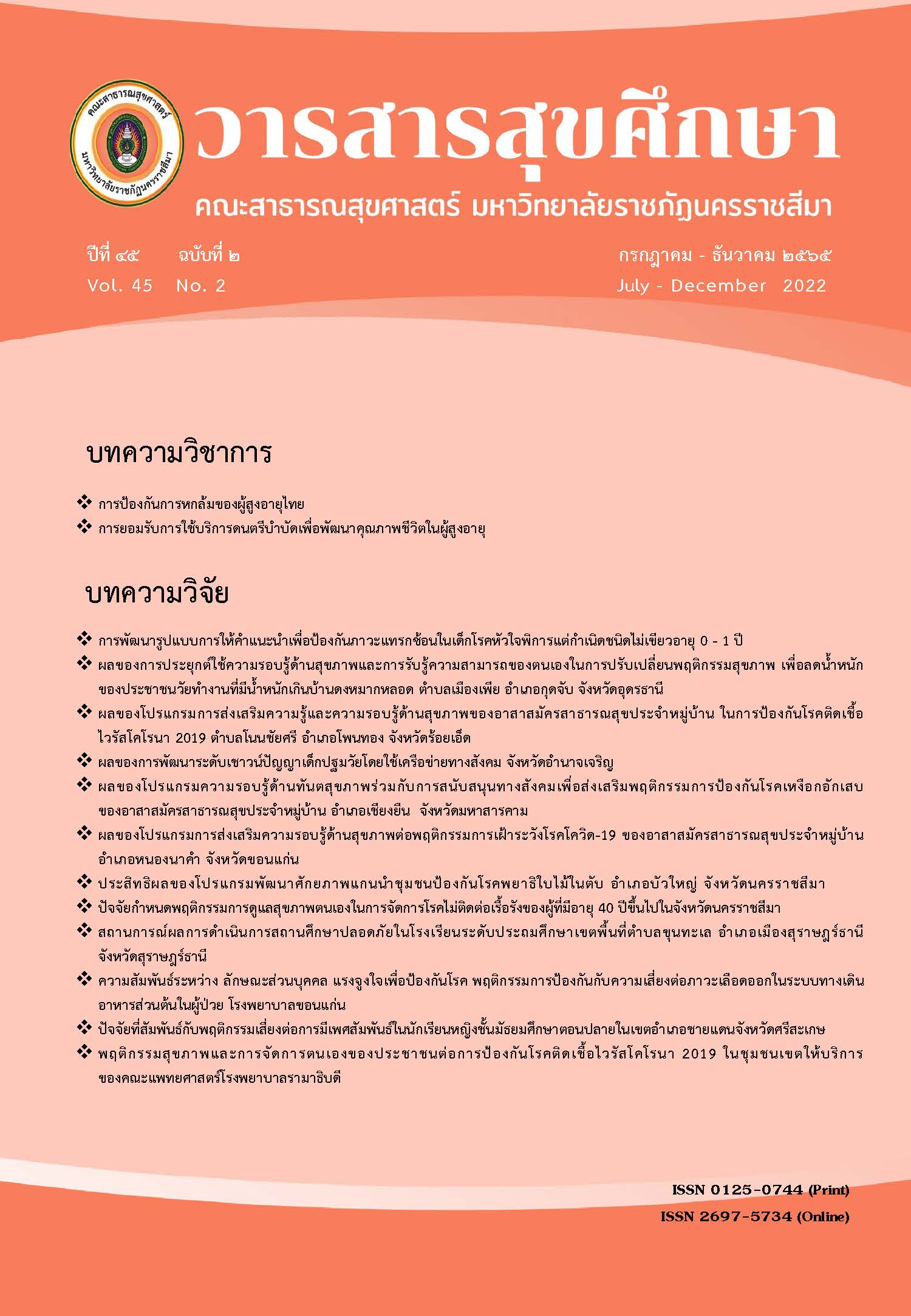Effect of Intelligence Quotient level Development of Early Childhood by social Networks, Amnat Charoen Province
Main Article Content
Abstract
This quasi-experimental research aimed to study the effects of developing early childhood intelligence quotient by using social networks in Amnat Charoen province. The sample group were 48 early childhood aged 2-5 years who were collected by simple random sampling (SRS). Quantitative data were collected by structured questionnaire interview, and the screening form of intelligence quotient assessment for children 2-5 years of age, 1987 edition, obtained by Department of Mental Health, Ministry of Public Health. Qualitative was analyzed by content analysis. Descriptive statistics and inferential statistics: Independent t-test were used for data analysis.
The results revealed that overall, preschool age children had an average intelligence quotient level at 100.64 scores (S.D.=17.36). Samples in the experimental group had an average intelligence quotient level at 105.60 scores (S.D.=14.36). The preschool age children who participated in early childhood intelligence development via social networks in Amnat Charoen province had the average intelligence quotient level at 105.60 scores (S.D.=14.08), which were statistically higher than the average intelligence quotient level of the comparison group at 95.60 scores (S.D.=19.13) at a significance level of 0.05.
Therefore, the development for childhood intelligence quotient should be carried out regarding holistic care. Preschool age children should be emphasized on a systematic thinking, learning environment surrounding, enabling to analyze and distinguish the situation and solving problems when facing appropriately. As well as social networking mechanism should be promoted in order to take part of the surveillance and developmental milestones to encourage them to learn and optimal grow up effectively according to their age.
Article Details

This work is licensed under a Creative Commons Attribution-NonCommercial-NoDerivatives 4.0 International License.
References
สำนักงานคณะกรรมการพัฒนาเศรษฐกิจและสังคมแห่งชาติ. ยุทธศาสตร์ชาติ พ.ศ. 2561-2580 (ฉบับย่อ). กรุงเทพฯ: [ม.ป.พ.]; 2561.
Sternberg RJ, Conway BE, Ketron JL, Bernstein M. People's conceptions of intelligence. Journal of personality and social psychology.1981; 41(1): 37.
Lynn R, Vanhanen T. National IQs: A review of their educational, cognitive, economic, political, demographic, sociological, epidemiological, geographic and climatic correlates. Intelligence. 2012; 40(2): 226-234.
จันทร์อาภา สุขทัพภ์, อัมพร เบญจพลพิทักษ์, วนิดา ชนินทยุทธวงศ์, ประเสริฐ จุฑา. ระดับสติปัญญานักเรียนไทยชั้นประถมศึกษาปี ที่ 1 ประจำปี พ.ศ. 2559. วารสารสุขภาพจิตแห่งประเทศไทย. 2561; 26(3): 161-173.
ศูนย์สุขภาพจิตที่ 10 อุบลราชธานี. ผลการสำรวจสถานการณ์ระดับสติปัญญาและความฉลาดทางอารมณ์เด็กไทยชั้นประถมศึกษาปีที่ 1 และปัจจัยที่เกี่ยวข้องประจำปี พ.ศ.2564. การประชุมคณะกรรมการเขตสุขภาพที่ 10 ครั้งที่ 6 ประจำปี งบประมาณ พ.ศ. 2565; สำนักงานเขตสุขภาพที่ 10 อุบลราชธานี. อุบลราชธานี: เขตสุขภาพที่ 10 อุบลราชธานี; 2565.
Mitchell JC. Social networks. Annual review of anthropology. 3: 279-299; 1974.
ดอนล่าร์ เสนา, วรพล วรสุวรรณโรจน์. เครือข่ายทางสังคมกับการมีส่วนร่วมในการพัฒนาเชิงพื้นที่ตามยุทธศาสตร์สี่แยกอินโดจีน. Journal of Graduate Review Nakhon Sawan Buddhist College. 2563; 8(2): 134-142.
ฐานริณทร์ หาญเกียรติวงศ์, รุจิกาญจน์สานนท์, นิติพัฒน์ กิตติรักษกุล. เครือข่ายทางสังคมกับการส่งเสริมสุขภาพ. วารสารวิชาการสังคมศาสตร์เครือข่ายวิจัยประชาชื่น. 2564; 3(1): 58-68.
อรุณ จิรวัฒน์กุล. ชีวสถิติสำหรับงานวิจัยทางวิทยาศาสตร์สุขภาพ.ขอนแก่น: หจก.โรงพิมพ์คลังนานาวิทยา; 2547.
วิสุทธิ์ กล้าหาญ, พูลพงศ์ สุขสว่าง. การพัฒนาเชาวน์ปัญญาด้านตรรกะและคณิตศาสตร์สำหรับนักเรียนประถมศึกษา: การศึกษาเชิง พฤติกรรม. Journal of Educational Measurement Mahasarakham University. 2562; 25(2), 239-254.
จุไรรัตน์ ประชุมรัตน์. ระดับเชาวน์ปัญญาและความสามารถทางการเรียนรู้ด้านการอ่าน การเขียนและการคำนวณของนักเรียนระดับชั้นประถมศึกษาปีที่ 2 ถึง 6 ของโรงเรียนแห่งหนึ่งในจังหวัดสุราษฎร์ธานี. Region 11 Medical Journal. 2563; 34(3): 22-34.
ผดุงศักดิ์ ศรีวาส, เลิศชัย เจริญธัญรักษ์. ปัจจัยที่เกี่ยวข้องกับระดับสติปัญญาของนักเรียนชั้นประถมศึกษาปีที่ 1 จังหวัด อุบลราชธานี. KKU Journal for Public Health Research. 2561; 11(3): 14-21.
Piaget J. The relation of affectivity to intelligence in the mental development of the child. Bulletin of the Menninger clinic. 1962; 26(3): 129.
สมบัติ เจริญเกษ, บัญญัติ ชานาญกิจ. ผลการจัดประสบการณ์แบบวิทยาศาสตร์ที่มีต่อความสามารถในการคิดวิเคราะห์ของ เด็กปฐมวัย; The Effect of Scientific Experience Arrangement on Critical Thinking Ability of Early Childhood. Journal of Graduate Studies in Northern Rajabhat Universities. 2557; 4(6): 117-128.
Vinson BP. Preschool and school-age language disorders. Cengage Learning. 2012.
Vygotsky L. Interaction between learning and development. Readings on the development of children. 1978; 23(3): 34-41.
อภิรพี เศรษฐรักษ์ ตันเจริญวงศ์, ศรีรัฐ ภักดีรณชิต, ญาณวุฒิ เศวตธิติกุล. พฤติกรรมการใช้หน้าจอของเด็กไทยวัย 0-3 ปี ในเขตกรุงเทพมหานคร. วารสารวิชาการนวัตกรรมสื่อสารสังคม. 2561; 6(2): 60-69.
วราลี เดชพุทธวัจน์. ความสัมพันธ์ระหว่างอายุที่เริ่มใช้สื่ออิเล็กทรอนิกส์และลักษณะสื่ออิเล็กทรอนิกส์กับพัฒนาการล่าช้าของเด็กอายุ 6 เดือน - 5 ปี. วารสารโรงพยาบาลนครพิงค์. 2563; 13(2): 1-19.
จีระวรรณ ศรีจันทร์ชัย, สุจิมา ติลการยทรัพย์. ผลกระทบจากการใช้สมาร์ทโฟนในเด็กปฐมวัย: บทบาทของพยาบาลในการช่วยเหลือดูแล. Journal of MCU Nakhondhat. 2564; 8(10): 113-124.
Mastoras SM, Saklofske, DH, Schwean VL, Climie, EA. Social support in children with ADHD: An exploration of resilience. Journal of attention disorders. 2018; 22(8): 712-723.
จิตตวิสุทธิ์ วิมุตติปัญญา. การพัฒนาเด็กปฐมวัยด้วยสะเต็มศึกษาบูรณาการกับแหล่งทรัพยากรการเรียนรู้และการมีส่วนร่วมของชุมชน. Integrated Social Science Journal, Faculty of Social Science and Humanities, Mahidol University. 2562; 6(1): 3-23.


